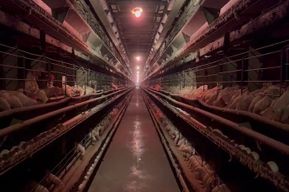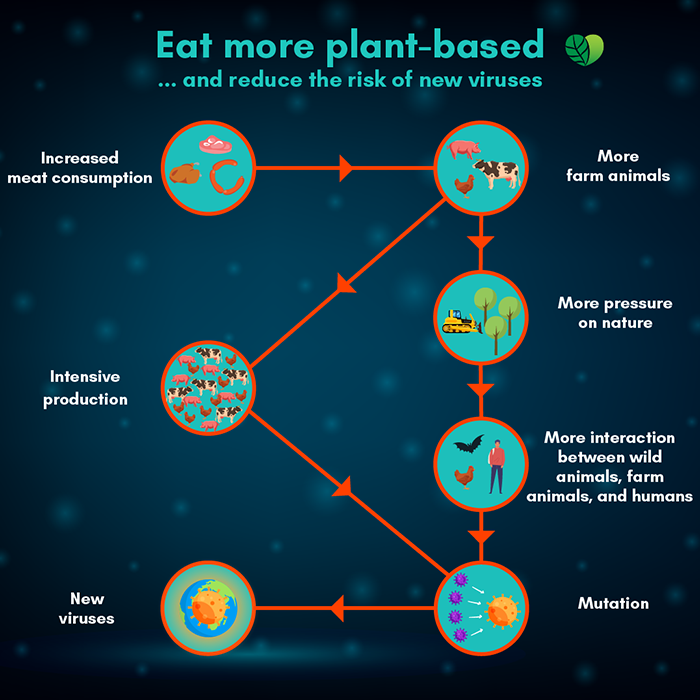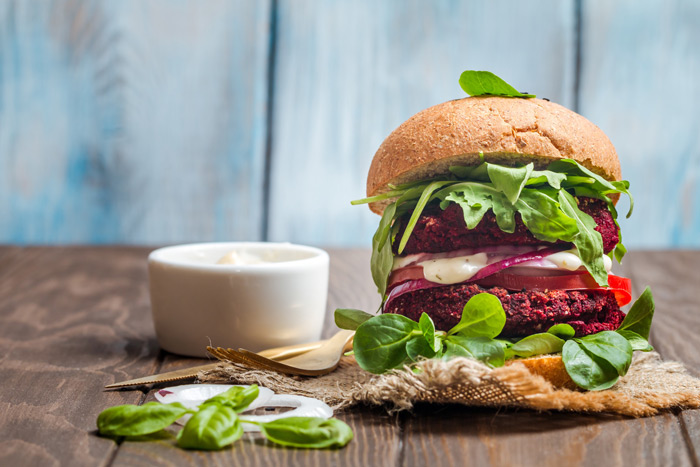
We have 30 days to take on Goliath – again
November 12, 2025
March 21, 2020
With the increasing epidemiological threat posed by the coronavirus SARS-CoV-2, a number of terms previously known almost exclusively to specialists have entered everyday language: “coronavirus”, “incubation period”, “infection vector”. In the long term, however, the most important of these terms may turn out to be “zoonosis” — a disease transmitted from animals to humans.

The 2019 coronavirus disease (COVID-19) is the latest in a series of rapidly spreading infectious diseases caused by animal-based viruses that have managed to cross the inter-species barrier and infect humans (the so-called zoonotic diseases)1.
Out of approximately 1400 pathogens known to modern medicine, more than 800 (~60%) originate from animals2. Almost every year, new pathogens of animal origin which pose a serious threat to humans are discovered3. In addition to COVID-19, these dangerous diseases caused by zoonotic viruses include avian and porcine influenza (commonly known as bird and swine flu), severe acute respiratory syndrome (SARS) and various types of haemorrhagic fever, including Ebola4.

Zoonotic infections are most often viral (less often bacterial) and occur either through direct contact with a sick animal or through consumption of its meat.
Researchers suspect that the source of the current spread of the coronavirus disease is the meat market in Wuhan, where many species of wild and domestic animals were sold under terrible conditions. In view of the public health risk posed by such markets, the Chinese authorities are currently phasing them out throughout the country5.
However, the far-away, exotic nature of Asian animal markets should not put our minds at ease. According to experts, one of the biggest epidemiological risk factors is currently the conventional system of livestock farming6. Factory farms where the vast majority of animals bred for consumption are kept are particularly dangerous7.
Due to the very high density and low genetic diversity of the animals kept there, farms of this kind provide an excellent space for the rapid spread of viruses. This phenomenon is also encouraged by the very high intensity of production, which causes chronic stress and consequently weakens the animals’ immune system. Potential drivers for the transmission of zoonotic diseases also include long-distance transport and the extensive supply chain used by the animal industry8.

Negative consequences of conventional animal husbandry are well illustrated by the studies on the development of pathogens originating from pigs. Between 1985 and 2010, global pork production increased by over 80%. During the same period, 77 new pathogens were identified on pig farms globally. None of them occur among these animals before 1985. 82% of these pathogens were found in the 20% of the countries with the highest share of pork meat production in the world9.
At least one of the pathogens originating from pigs has proved to be deadly to humans10. According to different estimates, during the A/H1N1 swine flu pandemic in 2009, between 100,000 and 400,000 people died worldwide, and a further 180,000 people died as a result of post-disease complications11.
In order to reduce the pathogenic potential of factory farming, animal producers commonly use antibiotics as a feed additive. This is also the case in Poland. Although the EU law prohibits the use of antibiotics for preventive purposes (they can only be used as treatment and under veterinary supervision), a report published in 2018 by the Supreme Audit Office (NIK) revealed that as many as 70% of Polish breeders inspected routinely used antibiotics (this percentage is even higher in the case of poultry farming: 82% for chickens and 88% for turkeys)12.

The widespread use of antibiotics in factory farming is considered by epidemiologists as one of the greatest threats to public health in the world13. As the consumption of animal products containing antibiotics increases, the risk of pathogens becoming immune to antimicrobial agents (the so-called antibiotic resistance) increases14.
Already today, infections caused by microorganisms resistant to antimicrobial mediations cause around 50,000 deaths per year in Europe and the US alone. According to a report drawn up in 2014 for the UK authorities, if this situation does not change, as many as 300 million people may die prematurely from antibiotic resistance worldwide by 205015.
In the light of the above data, it should not be surprising that the scientists involved in studying pandemics are convinced that the worst is, unfortunately, still ahead of us. As we read in a recent report for the World Health Organization, “if it is true to say “what’s past is prologue”, then there is a very real threat of a rapidly moving, highly lethal pandemic of a respiratory pathogen killing 50 to 80 million people and wiping out nearly 5% of the world’s economy. A global pandemic on that scale would be catastrophic, creating widespread havoc, instability and insecurity. The world is not prepared”16.

As we witness the fervent attempts of authorities in various countries around the world to stop the COVID-19 pandemic, we must be aware that we are currently only fighting the symptoms and effects, not the causes. The enormous effort and dedication of health professionals, sanitary and epidemiological services and scientists working on the vaccine will unfortunately not yield lasting results unless they are accompanied by systemic changes in the way we obtain and produce food.
As Liz Specht, PhD, the associate director of science and technology at the Good Food Institute says in response to the ongoing SARS-CoV-2 coronavirus pandemic, “It’s time to admit that we, as a civilization, have outgrown the dated notion of using animals to produce meat. Hunting and animal farming served their purpose for millennia of human population growth. But in 2020, we need to be brutally honest with ourselves. We can’t keep doing this. The current system is broken. It is inefficient, insecure, unsustainable, and extremely unsafe”17.
Fortunately, as the researcher adds, there is also an alternative for this system in the form of progressively more advanced production of meat analogues based on plant proteins, and the dynamically developing cellular agriculture sector (especially the so-called clean or cultured meat).

Burgers, sausages, cold cuts, cheese and milk based on high-protein legumes have been available on store shelves for many years. Until recently, however, the majority of the production in this area was done by small enterprises or played only a marginal part in the portfolio of big companies while the main customers were vegans, vegetarians and people with food allergies. Today, the growing interest expressed by customers on traditional diets drives the mass production of meat alternatives which is increasingly more often undertaken by major food companies such as Nestle, Unilever, Cargill or Tyson Foods8. Polish meat producers are also gradually exploring the plant-based market — sausages for Orlen and Żabka are prepared by ZM Silesia, while Sokołów or Pekpol offer their own lines of plant-based products. Given the strong interest among young Poles — as much as 39% of them eat such products, and 12% of that number do it regularly — it is to be expected that other local companies will also soon invest in meat alternatives19.
The extremely dynamic growth of the plant-based meat alternative sector is illustrated by the stock market story of one of its leaders, the American start-up called Beyond Meat. Shortly after its debut on NASDAQ, the value of the company’s shares increased by 734%, which was the best result achieved in the US under the initial public offering (IPO) in 201920.

This huge amount of money invested in the plant protein sector means not only an increasing availability of plant-based products, but also a possibility of conducting more and more advanced research on their nutritional, taste and texture properties. The resulting products, such as the above-mentioned Beyond Meat burgers, or their main competitor, Impossible Burger, are passing consecutive blind taste tests (most of the respondents are unable to distinguish them from conventionally sourced meat), thus satisfying the sensory needs of meat lovers without having to use animals kept in the dangerous factory farms21. What is important, these products often have better nutritional values than their meat counterparts and are free from antibiotic contamination and animal growth hormones. And all this with much lower use of natural resources and dramatically lower greenhouse gas emissions22.
What can be even more important for food security and sustainability is the rapidly growing cellular meat sector. The so-called clean meat is meat produced outside the animal’s body, after the tissues have been extracted from it23. Although its production is often regarded as laboratory work, clean meat facilities resemble modern micro-breweries much more than research and development centres. The products obtained in this way have the same nutritional values and taste as their traditional counterparts and do not involve the need of raising and killing animals. This enables clean meat producers to maintain a much higher level of biological and health protection and thus eliminate most of the epidemiological, and especially zoonotic, risks associated with traditional agriculture24.
Although cellular agriculture is still at the startup stage, very large funds have been invested in it by not only such people as Bill Gates, Richard Branson and Sergey Brin but also the tycoons of the conventional meat industry- American Tyson Foods and Cargill and German PHW-Gruppe (owners of Polish Drobimex). This allows us to hope that lab-grown meat will soon have a significant share in the food market25.
In the face of the growing zoonotic pandemic, intensification of efforts in order to quickly develop alternatives to industrial animal husbandry seems to be particularly important. Plant proteins and cellular meat may not allow us to combat the currently spreading zoonotic coronavirus, but they can significantly help us to protect ourselves from another threat of this kind. As dr Specht who was quoted earlier argues, “both plant-based and cultivated meat products remove the food insecurity and zoonotic disease concerns inherent in animal-based food. Modern plant-based and cultivated meat production gives consumers a painless swap at the dinner table, along with massive underlying benefits in safety and sustainability throughout the supply chain”26.
Włodzimierz Gogłoza, Ph.D is a Head of Policy at Otwarte Klatki and Anima International, and a former Assistant Professor of Law at the Maria Curie Sklodowska University in Lublin, Poland. During his stay in academia he co-authored one book, co-edited seven scholarly volumes, and published dozens of academic papers in fields relating to legal history, history of social movements, history of managerial thought and economic analysis of law.
